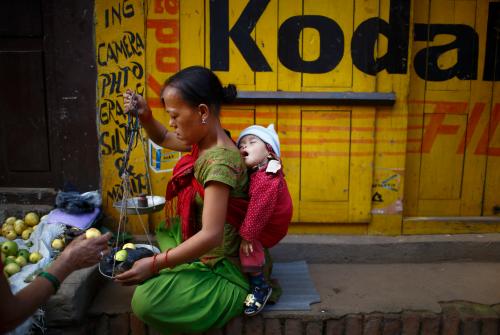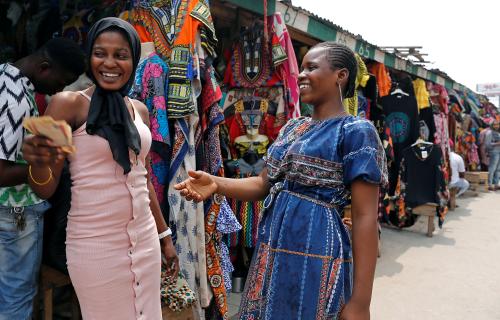At a time when 95 percent of Americans, and much of the world, is in lockdown, the often invisible and underappreciated work that women do all the time—at home, caring for children and families, caring for others (women make up three-quarters of health care workers), and in the classroom (women are the majority of teachers)—is becoming very visible. And its value is being recognized. Jokes by exhausted parents about how teachers should be paid a million dollars a day and videos of men showing off their baking skills abound in social media. Yet in ordinary times, much of “women’s work” is not valued, and women’s access to economic opportunities is often curtailed by this very undervaluation.
Models of economic growth continue to systematically ignore women’s unseen contributions to the economy, and struggle to integrate the costs of barriers to women’s economic empowerment. This inability to accurately measure the value of women’s work means that among a list of competing development priorities, gender often falls by the wayside. While most development organizations and governments tout the importance of women’s economic empowerment, gender is often an afterthought, integrated after programs are designed, rather than an intrinsic element in the problem identification and design process.
Yet women’s economic empowerment matters for growth; gender barriers may interact with other constraints in the economy, creating downstream spillover effects. At times, gender inequalities themselves may constrain aggregate growth. We recently attempted to illustrate this point by integrating a gender lens into one highly used growth diagnostic and prioritization tool, the Hausmann, Rodrik, and Velasco (HRV) growth diagnostic, to see if the tool is flexible enough to take some of these broader gender dynamics into account while still helping policymakers prioritize among a suite of needed reforms.
Key revisions in Engendered HRV
The HRV and tools like it are designed to help policymakers identify what obstacles are most constraining to growth in an economy. Using the model in Hausmann, Rodrik, Velasco (2005) as a starting point, we attempt to engender the tool, labeling where in the diagnostic a gendered lens might provide different insights into potential constraints to growth. Below we show the fully engendered HRV (Figure 1) and highlight a few key nodes where taking gender into account brings new insights.
Figure 1. Engendered HRV
Barriers to entrepreneurship (node A): The HRV starts from the premise that firm-level growth is constrained by low returns to economic activity or a high cost of financing. We argue that the number and quality of entrepreneurs themselves also matters, affecting both firm output and productivity. Everywhere, women participate in entrepreneurship at lower rates than men. This is not because of innate sex differences in entrepreneurial ability. It is because women often face greater obstacles to becoming entrepreneurs—lack of mentors and professional networks, less access to credit and productive inputs, and greater time constraints due to care responsibilities. When high-quality female entrepreneurs are not able to enter, lower-quality male entrepreneurs take their place. This lowers the average quality of entrepreneurs in the economy. It also reduces overall returns because management is worse than it would be under more-skilled female managers. This gender gap in entrepreneurship has real costs—an estimated 10 percent of long-run GDP in South Asia (see Table 1).
Table 1. Average income loss from labor market gender gaps
| Long-run income loss (% GDP) | ||
| Region | Entrepreneurship gap | All gender gaps |
| Central Asia | 7.1% | 10.1% |
| East Asia and the Pacific | 7.8% | 16.0% |
| Europe | 5.4% | 10.8% |
| Latin American and Caribbean | 5.3% | 17.3% |
| Middle East and North Africa | 7.7% | 37.8% |
| South Asia | 9.8% | 24.9% |
| Sub-Saharan Africa | 6.0% | 12.0% |
Source: Cuberes and Teignier (2016)
Misallocation of talent (node B2): In the original HRV tree, firms may be constrained by a lack of workers with the right skills due to “low human capital” in the economy. But another reason why firms may not get workers with the right skills is because the talent that does exist is not being utilized well. While girls and women are increasingly as educated as boys and men (and in many countries more so), this has not translated into equal employment opportunities. Social norms about what women should or should not do, unpaid care responsibilities, poor infrastructure, and safety concerns are all barriers that keep many women, even highly skilled women, from working or from working to their fullest potential. Discrimination by employers, and gender-based occupational segregation are additional reasons why women’s skills may not be fully utilized. The economic impact of this misallocation of talent is not trivial—the improved allocation of talent in the labor force, largely driven by the entrance of white women into highly skilled occupations, explains one-quarter of GDP per capita growth in the U.S. from 1960-2010.
(Invisible and unpaid) care responsibilities are a cross-cutting constraint (node B2.4): Everywhere in the world women are more time poor than men. In India, for instance, women spend almost 10 times more hours on unpaid care work per week as men. This lowers social returns to economic activity by reducing the amount of time women can spend on paid economic activities—pushing them to either work fewer hours or leave the workforce altogether. Care responsibilities also mean female entrepreneurs and farmers have less time to invest in their businesses and farms than men do. In Benin, female entrepreneurs devoted 18 percent fewer hours to their businesses than men did. In Ghana, 13 percent less.
Low private appropriability (node E): Having less time to invest in their business or farm reduces the return women can get from these economic activities. Gender gaps in access to assets, finance, and other production inputs and tools then compound the problem. As do gender differences in access to public services such as irrigation or agricultural extension. Reducing these gender gaps could yield substantial economic impacts. Take Malawi, where female farmers are on average 25 percent less productive than male farmers. It turns out that differences in access to male labor and agricultural implements explains over two-thirds of this productivity gap. If you could close the input gap so that female productivity matched male productivity, Malawi’s GDP would grow by $100 million (1.85 percent)!
Lessons learned
As the above brief discussion illustrates, it is possible to integrate gender into “growth constraints” models like the HRV. In our paper, we show how such an exercise yields new insights and understanding of how gender barriers can impact growth throughout the economy. But we also find that there are aspects of these models that limit their usefulness when it comes to integrating gender issues.
- Their emphasis on low supply, high demand constraints is not well suited to identifying problems due to misallocation of resources, such as women’s talent or skills, in a context of excess supply.
- The prioritization of short-term reforms (i.e., quick payoffs) downplays the importance of investments that may take a decade or two to pay off, as is often the case for gender equality, education, and health constraints.
- The static nature of the HRV makes it difficult to capture the downstream effects of greater gender equality.
- The emphasis on aggregate economic growth alone ignores the important distributional, inclusion, and poverty alleviation effects of any given constraint.
The fact is that constraints (whether market- or institution-based) are not distribution neutral—they affect some groups more than others. If a constraint is especially binding to a large group of the population, such as women, the poor, or rural residents, alleviating that constraint will have large impacts on the economy as a whole. Economic development is about more than just growth. As Amartya Sen argues, development should be thought of as an expansion of freedoms and opportunities for all. A growth path that does not explicitly integrate all parts of the population does not lead to real development. Thus, it is important to look at not only growth but poverty reduction and inclusion when designing policies and programs. Economic models like the HRV can be a useful tool for identifying priorities, but they are incomplete without a deeper rethink about how to elevate the importance of inclusion and poverty reduction in the analysis.
The Brookings Institution is committed to quality, independence, and impact.
We are supported by a diverse array of funders. In line with our values and policies, each Brookings publication represents the sole views of its author(s).










Commentary
Gender and growth: The constraints that bind (or don’t)
April 16, 2020